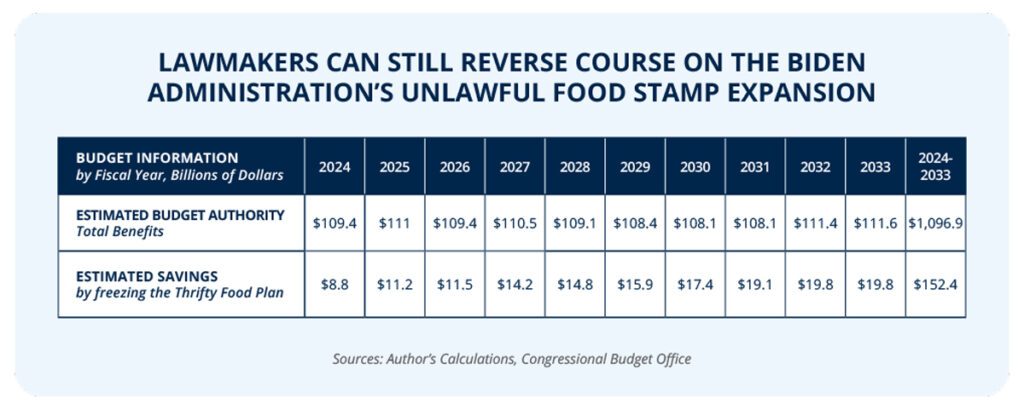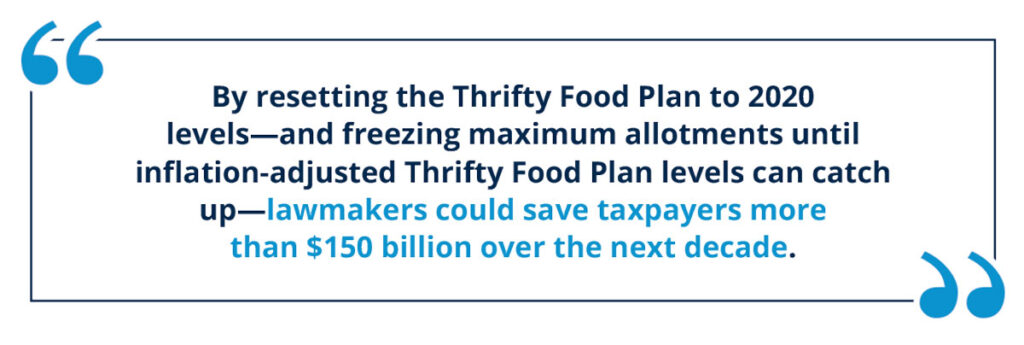Freezing the Thrifty Food Plan: How Congress Can Reverse Course After the Biden Administration’s Unlawful Food Stamp Expansion
Key Findings
- In 2021, the U.S. Department of Agriculture (USDA) implemented the largest food stamp increase in program history.
- This unilateral and unlawful expansion of food stamp benefits was done without the approval of Congress.
- The food stamp benefits expansion is playing a role in driving inflation.
- To combat this, Congress should reset the Thrifty Food Plan to 2020 levels, while also freezing maximum monthly allotments.
- Implementing these changes would save taxpayers more than $150 billion over the next decade.
Overview
In 2021, USDA made sweeping changes to the food stamp program under the direction of President Biden.1 Among these changes was the largest increase in food stamp benefits since the program’s inception—hiking benefits by 27 percent across the board.2 This comes at a huge cost to taxpayers, as the Congressional Budget Office (CBO) estimates that this expansion of welfare benefits will cost up to $250 billion over the next decade alone.3
After failing to get congressional approval, Biden bureaucrats charged ahead with unilaterally expanding food stamp benefits by reevaluating the Thrifty Food Plan.4 By pushing through this expansion, the Biden administration abandoned a 45-year cost neutrality policy within the food stamp program.5

While the situation is dire, lawmakers are not without solutions. By resetting the Thrifty Food Plan to 2020 levels and freezing maximum food stamp allotments at their current level until inflation-adjusted Thrifty Food Plan levels can catch up, Congress can save taxpayers more than $150 billion over the next decade.
USDA pushed through the largest food stamp expansion in program history
Soon after taking office, President Biden appointed Stacy Dean as Deputy Under Secretary for USDA’s Food, Nutrition, and Consumer Services—the agency that oversees the food stamp program.6 Prior to her appointment, she worked in the Clinton administration and at the left-wing Center on Budget and Policy Priorities, where she spent years advocating for food stamp expansions.7

Ms. Dean brought the same priorities with her into this new position, and together with other Biden officials, found a backdoor method of expanding the food stamp program.8 This ultimately resulted in the single largest food stamp expansion in program history—increasing benefits by an average of 27 percent.9 Assuming Biden bureaucrats do not unlawfully expand benefits again during the next reevaluation, the CBO estimates that this expansion will cost taxpayers up to $250 billion over the next decade.10 When pressed, Ms. Dean adamantly claimed that USDA moved forward with this expansion “based on Congress’s directive” that the Thrifty Food Plan be reevaluated.11 However, Congress did not direct USDA to abandon the longstanding cost neutrality policy.12

In 2018, when Congress enacted the latest version of the Farm Bill, USDA was required to periodically reevaluate the Thrifty Food Plan on a set schedule.13 These reevaluations were meant to update the plan’s contents based on food prices, food composition data, consumption patterns, and dietary guidance—the same factors used in every reevaluation since the Thrifty Food Plan was created.14 While being questioned by the U.S. Senate Committee on Agriculture, Ms. Dean admitted that this “directive” did not include instructions to reevaluate plan cost, increase benefit allotments, or abandon cost neutrality.15
The estimated cost of this alleged “congressional directive” to increase food stamp benefits never appeared in any official budget analyses of the Farm Bill, or any subsequent appropriations act.16 In fact, when Congress was considering the 2018 Farm Bill, the CBO estimated that the Thrifty Food Plan update would cost nothing.17 And just days before this illegal welfare expansion, the CBO anticipated only small changes to the Thrifty Food Plan based solely on inflationary adjustments.18
Even worse, President Biden’s 2022 budget proposal estimated that food stamp spending would decrease by more than 8.4 percent due to the expiration of pandemic-related increases in average benefits.19 Despite these claims from USDA, food stamp spending failed to decline in fiscal year 2022.20 In fact, spending catapulted to nearly $120 billion—much of which can be attributed to the Biden administration’s food stamp benefits expansion.21

The expansion of food stamp benefits is driving up inflation
By the end of 2022, taxpayers were spending $11 billion every month on the food stamp program—more than double the monthly costs in 2019.22-23 Much of this increase comes from the Biden administration’s expansion of the food stamp program, as at least 55 percent of new spending stems from the unlawful benefits expansion.24 And even after emergency allotments expired in February, food stamp spending still hovered around $9 billion per month—still nearly double the monthly costs from 2019. At this rate, the CBO estimates that food stamp spending could cost taxpayers more than $1 trillion over the next decade.25
Since he took office, President Biden has been on a record-shattering spending spree—and the expansion of food stamp benefits is one of the latest examples. The result has been an inflation crisis ravaging the nation and hiking grocery prices that are squeezing Americans at the supermarket.26 Studies have shown that when food stamps—or similar welfare programs—increase benefits, food prices increase as well.27 With monthly benefit allotments increasing, the demand for groceries has grown, resulting in higher prices for consumers. According to the Bureau of Labor Statistics and the Bureau of Economic Analysis, grocery prices have increased by at least 23 percent.28-31 Worse yet, increased food stamp spending beginning in 2019 may have caused grocery prices to spike by 15 percent.32
The inflation crisis is making life more difficult for everyday Americans, as their pocketbooks are being squeezed tighter with each passing day. To put a stop to this, Congress must intervene.
Lawmakers can still reverse course on the Biden administration’s unlawful food stamp expansion
While President Biden’s unlawful food stamp expansion was pushed through without congressional approval, the story does not have to end there. Federal lawmakers still have an opportunity to reverse course on the Biden administration’s food stamp expansion.

Lawmakers could repeal President Biden’s unlawful food stamp expansion entirely. But if Congress did not want to repeal the increase for existing enrollees, it could at least temporarily pause future benefit hikes. For example, Congress could reset the Thrifty Food Plan to 2020 levels, adjusted for inflation, without rolling back current benefit levels. It could then freeze maximum food stamp allotments at their existing levels until inflation-adjusted Thrifty Food Plan levels caught up to current benefit amounts. Given the size of the Biden administration’s unlawful food stamp expansion, and current inflation forecasts, this freeze could last until fiscal year 2032.33-35
Implementing these changes would ultimately save taxpayers at least $152 billion over the next decade.36 Lawmakers can further ensure that future administrations cannot unilaterally expand benefits for political reasons.
THE BOTTOM LINE: Congress should repeal President Biden’s illegal food stamp expansion.
The Biden administration’s recent expansion of food stamp benefits was unlawful and done without congressional input. As a result, taxpayers are on the hook for the decisions made by a politically motivated USDA. Without a change, this expansion not only sets a dangerous precedent, but will continue to bleed taxpayers as monthly benefit increases continue to drive inflation and higher grocery prices.
Fortunately, federal lawmakers have options at their disposal. By resetting the Thrifty Food Plan to 2020 levels—and freezing maximum allotments until inflation-adjusted Thrifty Food Plan levels can catch up—lawmakers could save taxpayers more than $150 billion over the next decade.

References
- Hayden Dublois and Jonathan Ingram, “President Biden unilaterally and unlawfully increased food stamp benefits,” Foundation for Government Accountability (2023), https://thefga.org/research/president-biden-increased-food-stamp-benefits.
- Ibid.
- Philip L. Swagel, “The cost of eight executive actions taken by the Biden administration,” Congressional Budget Office (2022), https://www.cbo.gov/system/files/2022-06/58231-Smith.pdf.
- Ibid.
- Hayden Dublois and Jonathan Ingram, “President Biden unilaterally and unlawfully increased food stamp benefits,” Foundation for Government Accountability (2023), https://thefga.org/research/president-biden-increased-food-stamp-benefits.
- Ibid.
- Ibid.
- Ibid.
- Ibid.
- Ibid.
- Ibid.
- Ibid.
- Ibid.
- Ibid.
- Ibid.
- Ibid.
- Ibid.
- Ibid.
- Ibid.
- Ibid.
- Ibid.
- Food and Nutrition Service, “SNAP monthly state participation and benefit summary,” U.S. Department of Agriculture (2023), https://www.fns.usda.gov/sites/default/files/resource-files/SNAPZip69throughCurrent-4.zip.
- Ibid.
- Approximately 54.8 percent of the annualized cost growth between December 2019 and December 2022 was caused by permanent benefit increases, compared to 35.2 percent caused by emergency allotments, and 10.0 percent caused by higher enrollment.
- Congressional Budget Office, “Supplemental Nutrition Assistance Program,” Congressional Budget Office (2023), https://www.cbo.gov/system/files/2023-05/51312-2023-05-snap.pdf.
- Michael Greibrok, “How Congress can rein in Biden bureaucrats’ spending spree,” Foundation for Government Accountability (2023), https://thefga.org/research/how-congress-can-rein-in-biden-bureaucrats-spending-spree.
- Jonathan Ingram, “Congress could save taxpayers billions by repealing President Biden’s unlawful food stamp expansion,” Foundation for Government Accountability (2023), https://thefga.org/research/congress-could-save-repealing-bidens-unlawful-food-stamp-expansion.
- Ibid.
- Ibid.
- Ibid.
- Ibid.
- Ibid.
- Author’s calculations based upon data provided by a proprietary microsimulation model estimating the expenditure impact of freezing maximum allotments at current levels until maximum allotments under a cost-neutral June 2020 Thrifty Food Plan adjusted for inflation caught up to the maximum allotments used in fiscal year 2023.
- Actual changes in the Thrifty Food Plan between June 2020 and May 2021, the Low Cost Plan between June 2020 and June 2021, and the Moderate Cost Plan between June 2020 and June 2021 were used to reconstruct where the Thrifty Food Plan would have been set in June 2021 absent USDA’s unlawful changes. Changes in the Thrifty Food Plan, Low Cost Plan, and Moderate Cost Plan since June 2021 were used to construct growth rates to fiscal year 2023.
- Projected changes in total enrollment and in inflation for the Thrifty Food Plan for fiscal years 2024 through 2033 were derived from data provided by the Congressional Budget Office. See, e.g., Congressional Budget Office, “Supplemental Nutrition Assistance Program,” Congressional Budget Office (2023), https://www.cbo.gov/system/files/2023-05/51312-2023-05-snap.pdf.
- Author’s calculations based upon data provided by a proprietary microsimulation model estimating the expenditure impact of freezing maximum allotments at current levels until maximum allotments under a cost-neutral June 2020 Thrifty Food Plan adjusted for inflation caught up to the maximum allotments used in fiscal year 2023.
